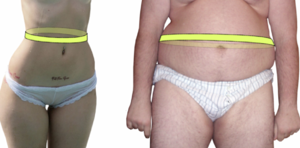Waist Measurement: Difference between revisions
No edit summary |
No edit summary |
||
| Line 5: | Line 5: | ||
</div> | </div> | ||
== Introduction == | == Introduction == | ||
[[File:Waist .png|right|frameless]] | |||
Waist measurement is a simple check to tell if you’re carrying excess body fat around your middle. | |||
* Your waist measurement is an indicator of the level of internal fat deposits that coat the heart, kidneys, liver, digestive organs and pancreas. | |||
* This can increase the risk of heart disease and stroke<ref name=":0">Heart Foundation [https://www.heartfoundation.org.au/heart-health-education/waist-measurement Waist Measurement] Available: https://www.heartfoundation.org.au/heart-health-education/waist-measurement (accessed 9.11.2021)</ref>. | |||
== Measuring the Waist == | |||
Waist Circumference: To measure waist circumference, patients should stand with their arms crossed on the contralateral shoulders. The placement of the measuring tape should be snugly around the lateral aspect of each ilium at the mid-axillary line. It is an essential measure of anthropometry in adults and children as it directly measures central adiposity. Increasing central adiposity is associated with an increased risk of morbidity and mortality due to an increased risk of diabetes and heart disease<ref>Casadei K, Kiel J. [https://www.ncbi.nlm.nih.gov/books/NBK537315/ Anthropometric measurement.] StatPearls [Internet]. 2020 Apr 28. Available: https://www.ncbi.nlm.nih.gov/books/NBK537315/<nowiki/>(accessed 9.11.2021)</ref>. | Waist Circumference: To measure waist circumference, patients should stand with their arms crossed on the contralateral shoulders. The placement of the measuring tape should be snugly around the lateral aspect of each ilium at the mid-axillary line. It is an essential measure of anthropometry in adults and children as it directly measures central adiposity. Increasing central adiposity is associated with an increased risk of morbidity and mortality due to an increased risk of diabetes and heart disease<ref>Casadei K, Kiel J. [https://www.ncbi.nlm.nih.gov/books/NBK537315/ Anthropometric measurement.] StatPearls [Internet]. 2020 Apr 28. Available: https://www.ncbi.nlm.nih.gov/books/NBK537315/<nowiki/>(accessed 9.11.2021)</ref>. | ||
Your health is at risk if your waist size is: | |||
# MEN: Over 94cm (about 37 inches) | |||
# WOMEN: Over 80cm (about 31.5 inches)<ref name=":0" /> | |||
== Sub Heading 2 == | == Sub Heading 2 == | ||
Revision as of 05:42, 9 November 2021
Original Editor - User Name
Top Contributors - Lucinda hampton, Boluwatife Williams and Chelsea Mclene
Introduction[edit | edit source]
Waist measurement is a simple check to tell if you’re carrying excess body fat around your middle.
- Your waist measurement is an indicator of the level of internal fat deposits that coat the heart, kidneys, liver, digestive organs and pancreas.
- This can increase the risk of heart disease and stroke[1].
Measuring the Waist[edit | edit source]
Waist Circumference: To measure waist circumference, patients should stand with their arms crossed on the contralateral shoulders. The placement of the measuring tape should be snugly around the lateral aspect of each ilium at the mid-axillary line. It is an essential measure of anthropometry in adults and children as it directly measures central adiposity. Increasing central adiposity is associated with an increased risk of morbidity and mortality due to an increased risk of diabetes and heart disease[2].
Your health is at risk if your waist size is:
- MEN: Over 94cm (about 37 inches)
- WOMEN: Over 80cm (about 31.5 inches)[1]
Sub Heading 2[edit | edit source]
Sub Heading 3[edit | edit source]
Resources[edit | edit source]
- bulleted list
- x
or
- numbered list
- x
References[edit | edit source]
- ↑ 1.0 1.1 Heart Foundation Waist Measurement Available: https://www.heartfoundation.org.au/heart-health-education/waist-measurement (accessed 9.11.2021)
- ↑ Casadei K, Kiel J. Anthropometric measurement. StatPearls [Internet]. 2020 Apr 28. Available: https://www.ncbi.nlm.nih.gov/books/NBK537315/(accessed 9.11.2021)







